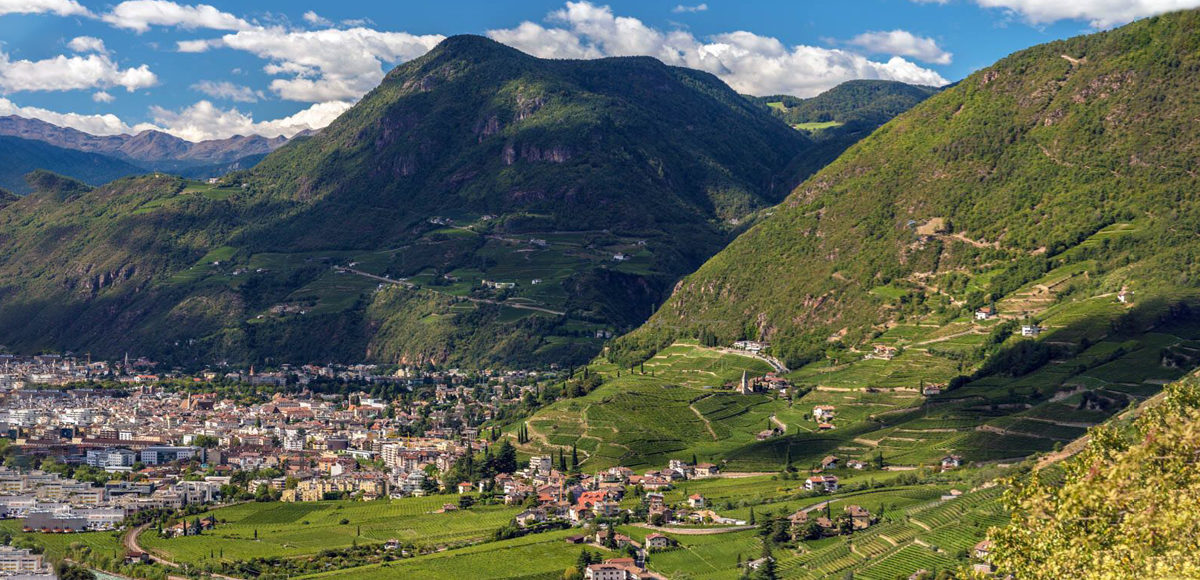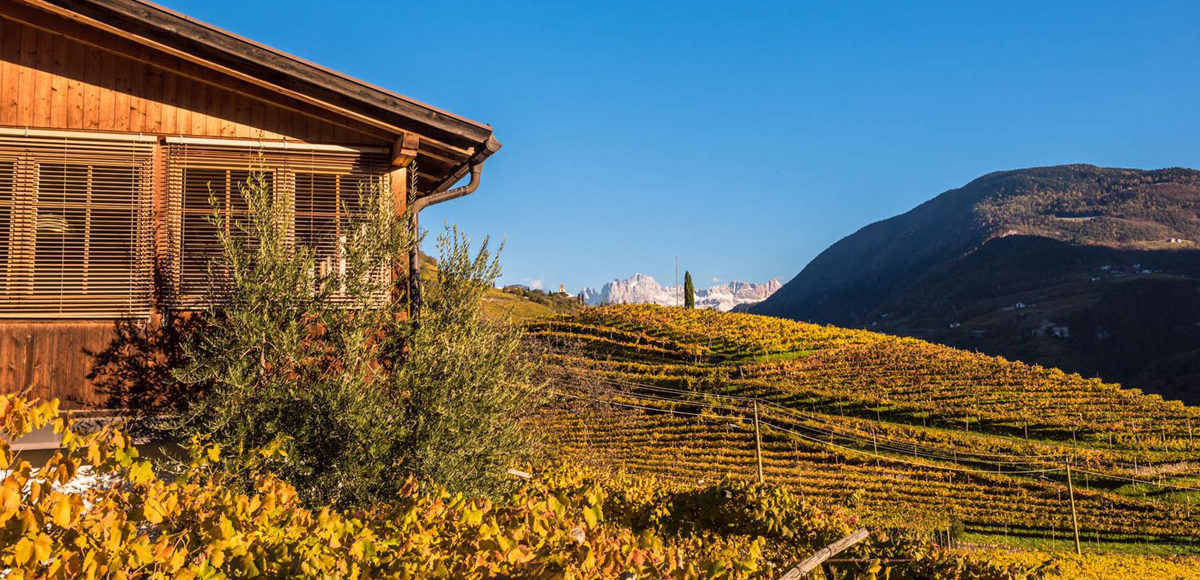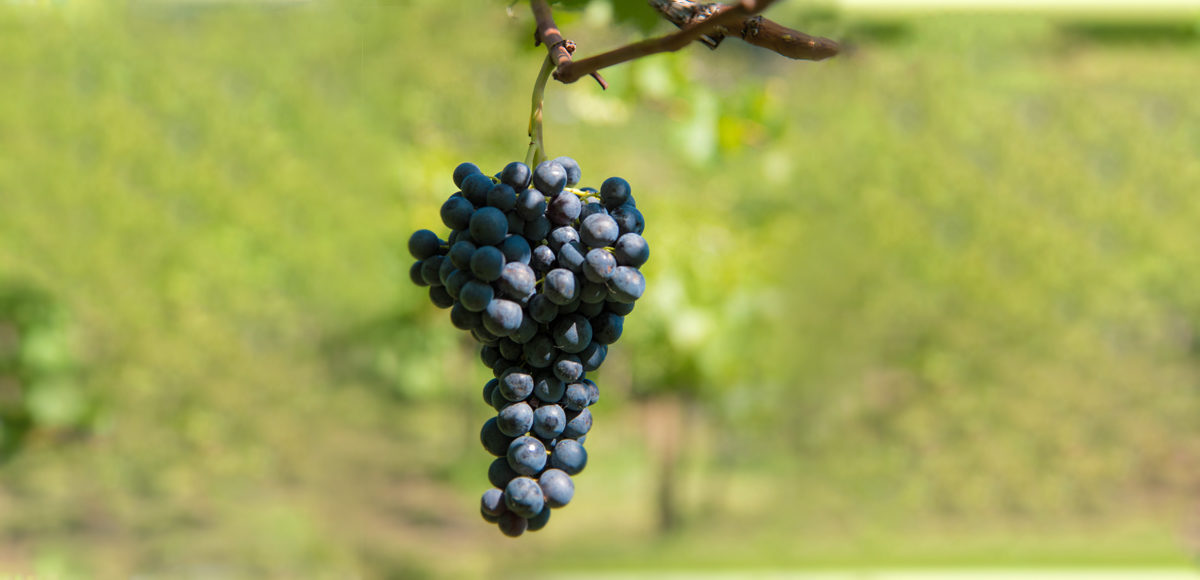“We really believe in our two autochthonous varieties: schiava and lagrein. Our focus is on producing wines of good drinkability, elegance, and depth.” — Florian Ramoser
Florian and Georg Ramoser are the tight father-son team behind a sharply focused set of wines from schiava and lagrein, two native red varieties synonymous with Alto Adige/Südtirol. Untermoserhof, the Ramoser family home and winery that dates to 1640, sits just above Bolzano, where it looks onto the green depths of Val d’Isarco/Eisacktal and the staggering Alpine panorama just beyond. Schiava, the bright, floral main grape in the traditional St. Magdalener blend, and its more soulful partner, lagrein, are entirely in their element on the four hectares of tiny parcels clustered around Untermoserhof. Steep slopes, challenging varieties, and the Ramosers’ dedication to minimal-input farming demand rigorous handwork in the vineyards. Their concentration on old vines, dense plantings, controlled yields, and thoughtful cellar work is giving exceptional results — dense, spice-tinged lagrein and vivid, inflected St. Magdalener. They are vibrant, supremely drinkable expressions of a region that is realizing its full potential for wines of distinctive depth and elegance.
Untermoserhof
The estate was established in 1640, likely taking its name, as Florian explains, “from ‘Moser,’ a common name in the region for someone living near a bog” — marshland having been a feature of the river-riven Bolzano landscape centuries ago. From the start, Untermoserhof was a place of mixed farming, included vineyards; it remained so, by necessity, through the Ramosers’ acquisition of the property in the late 1700s right up until WWII. “After the war, as times slowly got better, my family wanted to concentrate on cultivating and making only wine,” Florian explains. The shift from subsistence farming to viticulture took place within a single generation. Florian drives home the starkness of the transition: “My father told me that, in the ‘80s, when he started to reduce yields in the vineyard by doing green harvest, his father (my grandfather) couldn’t believe it. My grandfather’s generation couldn’t handle seeing grapes on the ground — understandably after what they had gone through. So every year in July my grandfather went on holidays and told my father to cut the grapes during that week so he didn’t have to see that. Only after some years, when my father, among other winemakers, started to have success with his ‘new’ wines, did my grandfather and his generation started to understand it.” Untermoserhof has always been passed from father to son, but Georg and Florian, the fourth and fifth generations, work as a team, sharing responsibility for both the vineyards and cellar. Florian notes: “2018 was my second harvest at home. My father has the experience and I try to adapt little things with my ideas — but we decide everything together. “
Georg and Florian Ramoser
Georg developed his understanding of Alto Adige’s native varieties growing up among the vines at Untermoserhof and through work experiences at Alois Lageder and Cantina di Bolzano. Florian realized he wanted to be a winemaker, “already when I was a kid. Growing up, seeing your father and family work the vines the whole year and then harvest them is very special.” He went on to study in neighboring Trentino and work for Luciano Sandrone, in Barolo. “Wine is a big part of my life,” Florian explains, “because many friends of mine are wine producers, too. We travel a lot to other wine regions and we meet very often to taste blind or in someone’s cellar from barrel. Other than wine, I really like playing ice hockey and just being with friends, going out for dinner and travelling. At home, we really love Barolo and Barbaresco, and French wines, too, especially white and red Burgundy, but also syrah from the Côte du Rhône.”
Santa Magdelena/Bolzano
Although Alto Adige/Südtirol looks back on two millennia of winemaking, its recent history was dominated by coops and it is only now truly emerging as a region for thrilling discovery of small individual producers. Culturally, it’s a place of intersection. Sited at a critical transalpine crossing, the region was long an object of contest between Bavarian dukes and Habsburg sovereigns, only coming under Italian rule at the end of WWI. But the language, architecture, cuisine — and wines — retain an individualistic Tyrolean soul. Few places are as traditional and yet transformed by recent history: Bolzano’s strategic value as a transport hub attracted heavy aerial bombing during WWII. Aggressive post-war rebuilding then swelled the city, pushing it deep into the farmland and vineyards that had surrounded it for centuries. Climatically, despite its Alpine location and latitude, Bolzano sits at the base of a great, heat-trapping bowl where average summertime temperatures exceed those of Palermo. The Alps catch most of the clouds and rain, making Bolzano’s weather reliably dry and clear, with some 300 sunshine days per year.
Lagrein and schiava
The two red varieties most closely associated with Bolzano and its immediate surroundings, schiava and lagrein, love this steady warmth and grow best in the calcareous, gravelly soils that trap and retain heat to aid ripening. They retain their freshness thanks to the starkly cooler mountain air that descends from the mountains each night.
Everywhere it is grown, schiava (a.k.a. vernatsch, trollinger), a generous bearer, has suffered from overcropping, leading to its reputation for giving anemic wines. But careful producers like Georg and Florian have trained their focus on older vines, green harvests, and careful cellar work to control yields and elicit characteristic vibrancy and delicacy from the variety. St. Magdalener is the region’s traditional schiava-dominant blend that is deepened by the addition of a small percentage of lagrein. The “Classico” designation identifies wines from historic sites on the northeastern edge of Bolzano.
Lagrein is one of Italy’s oldest native grapes. Its history goes back a thousand years in Alto Adige/Südtirol and it is, deservedly, one of northern Italy’s most prized red varieties. However, it is finicky, susceptible to coulure and prone to uneven yields, which has limited its appeal to growers outside the region. Recent DNA profiling suggests lagrein is the offspring of teroldego and kin to pinot noir and syrah; it shares noticeable aroma, flavor, and pigmentation characteristics with each. Lagrein gives one of the most deeply colored wines in Italy due to its high concentration of anthocyanins. It is also famously tannic, requiring careful management through aging in wood. A more refined understanding of lagrein biotypes (thought to number around 100, though most growers focus on just two) along with better understanding of its vinification needs have helped winemakers like the Ramosers capture the variety’s potential to give gloriously multilayered and complex yet highly drinkable wines.
Vineyards and farming
“We really believe in our two main varieties, schiava and lagrein, and want to focus especially on them,” Florian says — in notable contrast to many producers in the area, who still work with international varieties that have been popular here since the Hapsburg era. “We try to produce wines that express their vineyard’s character, showing terroir, depth, juiciness, and good drinkability.” The winery is 320 meters [nearly 1,000 feet] above sea level and the vineyards range from 280 to 400 meters [840 to 1,200 feet] a.s.l., with lagrein in the lower vineyards and schiava on the higher, steeper slopes, where the soil is less fertile. The vineyards cultivated with schiava (for St. Magdalener) and lagrein are all within the Santa Magdalena zone, at the northeast border of Bolzano. The vineyards are tiny parcels, some scattered around the winery and others a couple hundred meters away.” Vines range in age from 40 to 60 years old, with 100% pergola training for schiava — traditional for this variety, with its impressively pendular clusters — and a mix of pergola and guyot for lagrein.
Soils here are well-draining glacial and alluvial sandy loam and decomposed porphyry gravel. Florian explains that “the primary rock — volcanic ‘Quarz-Porphyr’ of Bolzano — dates back 270 million years. The soils of Santa Magdalena particularly were formed by glacial drifts containing porphyry gravel as well as alluvial deposits that enriched the soil with stones from the more northern parts of Alto Adige.” He thinks the lighter soils of the Hueb result in smaller bunches and berries, so “wines from the soil tend to be deeper and have more structure and spiciness.” Florian is convinced that, for Santa Magdalena, “having high density of vines — 6,000 to 8,000 per hectare — is important. This leads to roots that go deeper into the soil for more mineral, more concentrated wines with more depth.”
“We have about 4-5 % of lagrein in our St. Magdalener [DOC rules allow up to 15%] which, in the old vineyards, was planted together with schiava in the same parcel. It’s harvested together and coferments. These are two varieties that ripen at the same time, so it works pretty well,” Florian notes. He believes the greatest challenges and advantages of the area are: “the steepness of some our vineyards, which makes work pretty time-intensive ( about 600-800 hours per hectare/year). It can be challenging to keep fungus under control. On the other side, we have lots of sun hours and we reach full ripeness every year, even in colder and wetter years.”
“Almost everything has to be done by hand in our vineyards,” Florian underscores. “Most of the vineyards have narrow terraces we can’t enter with any tractor, just with a small crawler vehicle. Strong selection already takes place in the vineyard.” He and Georg work “as naturally as we can,” he says, “looking always to improve soil characteristics, plant characteristics, and to try to adapt things for improvement.” This includes careful canopy management and monitoring the health of the grapes, as well as trials with cover crops. “We are farming almost organically — I say almost because we make one or two [conventional] treatments only if it is needed in the most dangerous moments. We haven’t use herbicides in many, many years.”
In the cellar
Florian says he and his father share a “pretty similar” approach to style. “I’m convinced to let the vineyard express itself in the wine, trying to not do too much in the cellar. We don’t want to cover the fruit of our wines with too much new oak or something.” He explains that his father, along with the rest of Italy, seemingly, experimented with barrique for a time: “But since a couple of years, we use bigger barrels and about 25%, down from 40%, new oak. This leads to maybe a little less concentration in the wines, but more elegance and freshness.” Vinification is, in Florian’s words, “pretty traditional”: destemming, selected yeasts, and stainless steel and large oak barrels for alcoholic fermentation and aging. “The thing I’m experimenting with a little bit right now is using whole bunches during fermentation for lagrein — it leads to more depth and more spiciness.”
For the St. Magdalena, fermentation takes place in stainless steel and large oak cask that is also used for lagrein. During fermentation, pump overs are done twice a day initially, then once daily toward the end. After 10-14 days, wines are racked and pressed. Afterward, half the wine goes through malo in large oak and half in stainless. The wines age for about seven months, before bottling in May or June.
For Lagrein, fermentation takes place in stainless, with pumpovers twice daily “until almost the end of fermentation, to softly extract tannin structure.” The wine is racked and pressed and put in 2,500L oak barrels for malo and eight months of elevage. Normally, one bottling takes place in May, another in June.
For Lagrein Riserva, fermentation is split between stainless and large oak. Pump overs are done twice daily for the oak batch and pigeage for the stainless steel lot for the first five to six days, then pump overs are done, with care taken to avoid overextraction. After 18-20 days, the wines are racked and pressed, and put into 500L oak barrels for malo and 10-12 months elevage. After a year, they are racked again into in 2,500L oak barrels for a few months before bottling.


















